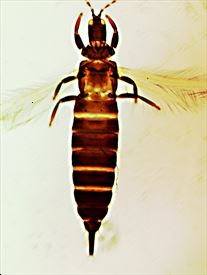Distinguishing features
Both sexes fully winged. Female dark brown, darkest on head and tube; antennal segments III–V with pedicels yellow to pale brown; tarsi pale brown; major setae brown, with terminal setae of tube darkest; fore wings strongly shaded. Head longer than wide, finely sculptured; ocelli present; compound eyes slightly smaller ventrally than dorsally; 1 pair of finely acute postocular setae; maxillary stylets wide apart, V-shaped, retracted more than halfway towards eye. Antennae 7-segmented; VII and VIII completely fused; III and IV each with 2 long sense cones. Pronotum weakly sculptured near margins; setae finely acute, with epimerals longer than posteroangulars; basantra absent; ferna large. Mesonotal midlateral setae moderately developed; mesopresternum broadly boat-shaped. Metanotum reticulate medially; median setae about as long as mesonotal midlaterals. Fore femora slender; fore tarsal tooth small, curved, at inner apical margin. Fore wings with 3 major sub-basal setae, S3 the longest. Pelta broadly rounded medially; tergite II slightly eroded laterally with posteroangular setae not developed; tergites II–VII with 1 pair of sigmoid wing-retaining setae; tergite IX posteromarginal setae slightly more than half as long as tube, with S1 shorter than S2; tube as long as head, slightly constricted apically; anal setae less than half as long as tube.
Male similar to female, but large males with a small tubercle ventrally on frons, approximately underlying posterior ocelli; pronotal midlateral setae elongate; fore femora swollen; fore tarsal tooth greatly enlarged. Small males lack these characters, and have the fore tarsal tooth relatively small.
Related species
The genus Ozothrips appears to be closely related to Heptathrips and Cleistothrips, and includes five species, all known only from New Zealand. O. priscus has antennae similar to those of Heptathrips and Cleistothrips, with 2 sense cones on segments III and IV, in contrast to the other members of Ozothrips.
Biological data
Spore-feeding on dead branches, and abundant on dead, leafy branches of Nothofagus in mature forest with a closed canopy.
Distribution data
Known only from New Zealand (TO / SD, NN, BR).
Family name
PHLAEOTHRIPIDAE, IDOLOTHRIPINAE
Species name
Ozothrips priscus Mound & Palmer
Original name and synonyms
Ozothrips priscus Mound & Palmer, 1983: 26
References
Mound LA & Palmer JM (1983) The generic and tribal classification of spore-feeding Thysanoptera (Phlaeothripidae: Idolothripinae). Bulletin of the British Museum (Natural History). Entomology 46: 1–174.
Mound LA & Walker AK (1986) Tubulifera (Insecta: Thysanoptera). Fauna of New Zealand 10: 1–140.

